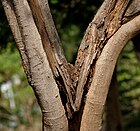Note: This is a project under development. The articles on this wiki are just being initiated and broadly incomplete. You can Help creating new pages.
Difference between revisions of "Pongamia pinnata - Naktamala"
(→Parts Used) |
|||
| (5 intermediate revisions by 2 users not shown) | |||
| Line 1: | Line 1: | ||
| − | [[File:Pongamia pinnata.jpg|thumb|right|''Naktamala'', ''Pongamia pinnata'']] | + | [[File:Pongamia pinnata.jpg|200px|thumb|right|''Naktamala'', ''Pongamia pinnata'']] |
'''Naktamala''' is a species of tree in the pea family, Fabaceae, native in tropical and temperate Asia including parts of Indian subcontinent, China, Japan, Malesia, Australia and Pacific islands. | '''Naktamala''' is a species of tree in the pea family, Fabaceae, native in tropical and temperate Asia including parts of Indian subcontinent, China, Japan, Malesia, Australia and Pacific islands. | ||
| Line 13: | Line 13: | ||
==Common names== | ==Common names== | ||
| − | {{Common names|kn=Honge|ml=Ponnu, Unnu|sa=Karanjah|ta=Pungai|te=Pungu|hi= | + | {{Common names|kn=Honge|ml=Ponnu, Unnu|sa=Karanjah|ta=Pungai|te=Pungu|hi=Aranj|en=Pongam Tree, Indian Beech Tree}} |
==Properties== | ==Properties== | ||
| Line 36: | Line 36: | ||
==Identification== | ==Identification== | ||
===Leaf=== | ===Leaf=== | ||
| − | {{Leaf|Simple| | + | {{Leaf|Simple|Alternate|Leaves alternate, imparipinnate with long slender leafstalk, hairless}}<ref name="Leaf"/> |
===Flower=== | ===Flower=== | ||
| Line 43: | Line 43: | ||
===Fruit=== | ===Fruit=== | ||
| − | {{Fruit||7–10 mm |Plattened but slightly swollen, slightly curved with short, curved|With hooked hairs| | + | {{Fruit||7–10 mm |Plattened but slightly swollen, slightly curved with short, curved|With hooked hairs|Many}} |
==Where to get the saplings== | ==Where to get the saplings== | ||
| Line 60: | Line 60: | ||
| − | + | ||
| Line 73: | Line 73: | ||
<references> | <references> | ||
| − | <ref name="chemical composition">[http://www.spicesmedicinalherbs.com/pongamia-pinnata.html | + | <ref name="chemical composition">[http://www.spicesmedicinalherbs.com/pongamia-pinnata.html Constituents]</ref> |
| − | <ref name="Leaf">[https://web.archhttp://www.worldagroforestry.org/treedb2/AFTPDFS/Pongamia_pinnata.PDF | + | <ref name="Leaf">[https://web.archhttp://www.worldagroforestry.org/treedb2/AFTPDFS/Pongamia_pinnata.PDF Plants characterristics]</ref> |
| − | <ref name="How to plant/cultivate">[https://www.pfaf.org/user/Plant.aspx?LatinName=Pongamia+pinnata | + | <ref name="How to plant/cultivate">[https://www.pfaf.org/user/Plant.aspx?LatinName=Pongamia+pinnata Cultivation details]</ref> |
</references> | </references> | ||
| Line 87: | Line 87: | ||
[[Category:Herbs]] | [[Category:Herbs]] | ||
| + | [[Category:Repeat plant]] | ||
Latest revision as of 15:36, 3 June 2023
Naktamala is a species of tree in the pea family, Fabaceae, native in tropical and temperate Asia including parts of Indian subcontinent, China, Japan, Malesia, Australia and Pacific islands.
Contents
Uses
Cough, Cuts, Fever, Wounds, Skin eruptions, Wound, Infectious diarrhea, Sore throats
Parts Used
Tender shoots, Leaves, Roots, Flowers, Seeds.
Chemical Composition
Indian beech tree is reported to contain alkaloids demethoxy-kanugin, gamatay, glabrin, glabrosaponin, kaempferol, kanjone, kanugin, karangin, neoglabrin, pinnatin, pongamol, pongapin, quercitin, saponin, b-sitosterol, and tannin.[1]
Common names
| Language | Common name |
|---|---|
| Kannada | Honge |
| Hindi | Aranj |
| Malayalam | Ponnu, Unnu |
| Tamil | Pungai |
| Telugu | Pungu |
| Marathi | NA |
| Gujarathi | NA |
| Punjabi | NA |
| Kashmiri | NA |
| Sanskrit | Karanjah |
| English | Pongam Tree, Indian Beech Tree |
Properties
Reference: Dravya - Substance, Rasa - Taste, Guna - Qualities, Veerya - Potency, Vipaka - Post-digesion effect, Karma - Pharmacological activity, Prabhava - Therepeutics.
Dravya
Rasa
Tikta (Bitter), Kashaya (Astringent)
Guna
Laghu (Light), Ruksha (Dry), Tikshna (Sharp)
Veerya
Ushna (Hot)
Vipaka
Katu (Pungent)
Karma
Kapha, Vata
Prabhava
Habit
Identification
Leaf
| Kind | Shape | Feature |
|---|---|---|
| Simple | Alternate | Leaves alternate, imparipinnate with long slender leafstalk, hairless |
Flower
| Type | Size | Color and composition | Stamen | More information |
|---|---|---|---|---|
| Unisexual | 4-5 mm long | Yellow | 5-20 | Inflorescence raceme-like, axillary, 6-27 cm long, bearing pairs of strongly
fragrant flowers |
Fruit
| Type | Size | Mass | Appearance | Seeds | More information |
|---|---|---|---|---|---|
| 7–10 mm | Plattened but slightly swollen, slightly curved with short, curved | With hooked hairs | Many | {{{6}}} |
Where to get the saplings
Mode of Propagation
How to plant/cultivate
Native to humid tropical and subtropical environments, it is found at elevations from sea level to 1,200 metres[3]
Commonly seen growing in areas
Lowland forest, Rocky coral outcrops on the coast, Along the edges.
Photo Gallery
References
External Links
- Ayurvedic Herbs known to be helpful to treat Cough
- Ayurvedic Herbs known to be helpful to treat Cuts
- Ayurvedic Herbs known to be helpful to treat Fever
- Ayurvedic Herbs known to be helpful to treat Wounds
- Ayurvedic Herbs known to be helpful to treat Skin eruptions
- Ayurvedic Herbs known to be helpful to treat Wound
- Ayurvedic Herbs known to be helpful to treat Infectious diarrhea
- Ayurvedic Herbs known to be helpful to treat Sore throats
- Herbs with Tender shoots used in medicine
- Herbs with Leaves used in medicine
- Herbs with Roots used in medicine
- Herbs with Flowers used in medicine
- Herbs with Seeds used in medicine
- Herbs with common name in Kannada
- Herbs with common name in Hindi
- Herbs with common name in Malayalam
- Herbs with common name in Tamil
- Herbs with common name in Telugu
- Herbs with common name in Sanskrit
- Herbs with common name in English
- Habit - Tree
- Index of Plants which can be propagated by Seeds
- Index of Plants which can be propagated by Cuttings
- Herbs that are commonly seen in the region of Lowland forest
- Herbs that are commonly seen in the region of Rocky coral outcrops on the coast
- Herbs that are commonly seen in the region of Along the edges
- Herbs
- Repeat plant



